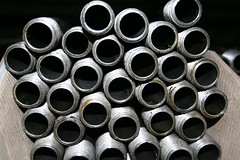The Pipes method of building mashups does require some time to learn. (I spent 15 minutes, which admittedly is not a great deal of time. Yet, that would seem to be a reasonable threshold if they want the 'average' person to use it to create mashups) They use terminology and structure that is used may turn away many potential mashers that have a
 non-technical orientation. I had hoped to use Pipes has a tool to teach librarians about SOA and Web Services. It is going to take some time to figure out if it can be used for teaching.
non-technical orientation. I had hoped to use Pipes has a tool to teach librarians about SOA and Web Services. It is going to take some time to figure out if it can be used for teaching.The number of sources from which to build mashups is limited at this time which limits creating mashups relevant to libraries. The also seems to take quite a while for the tool to load the sample Pipes. I learned HTML by tearing apart other people's code and hope I can learn Pipes using a similar method.
Microsoft's Popfly is another plug-and-play mashup tool. Like with Pipes, one can drag prefab building blocks. mashup that you can add to an existing Web page or turn into its own site. For example, one can produce a mashup that grabs pictures from a site like Flickr and then displays them in a rotating cube. As with a growing number of new tools, PopFly is invitation based and requires a WindowsLive ID.
Photo: "The Pipes, The Pipes" by Steve Garfield. Published through Creative Commons license. Sphere: Related Content




No comments:
Post a Comment